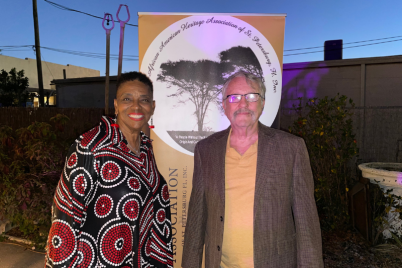By Gwendolyn Reese
I would like to thank you for your patience during a very challenging time for me. Six weeks ago, I had a terrible fall fracturing several bones in my big toe, and for the last five weeks, I’ve been downsizing, packing, moving, unpacking, and settling into my new home.
I AM back and will once again write my bi-weekly column, the first of which is part one highlighting Mercy Hospital and its pioneering physicians.
Mercy Hospital, as we know it, opened in 1923. However, this was not the original Mercy Hospital. Ten years earlier in 1913, Mercy Hospital was about to come into being when the Samaritan Hospital was moved from Seventh Street and Sixth Avenue South to 1150 Fourth Ave. S to become the first health care facility for African-American residents.
Although there was a hospital in St. Petersburg as early as 1906, it was not opened to African Americans. The hospital, the St. Petersburg Sanitarium, was located on Second Street near First Avenue North. It was soon followed by a second hospital built in 1910, the St. Petersburg Emergency Hospital, later known as Samaritan Hospital. Neither of these hospitals provided medical care to black residents.
Charles M. Roser, a prominent local developer for whom Roser Park is named, offered to move the Samaritan Hospital to a new location to serve as a “Negro hospital.” The reasons for supporting the Negro hospital varied among the white community from feeling that everyone deserved medical care to the desire to confine communicable diseases within the black communities.
There were no doctors on staff. A handful of nurses ran the hospital. Often referred to as the “pest house,” Mercy primarily treated patients with communicable diseases such as tuberculosis or smallpox; it did not provide quality health care.
In 1922, the City of St. Petersburg purchased five acres of land on 22nd Street South to build the new Mercy Hospital. The construction costs were estimated to range from $15,000 to $17,000. A bond provided $10,000, Edward Tomlinson donated $1,000, and the city hospital board agreed to pay the difference.
Progress on the construction of the new hospital was very slow, but finally, in 1923, the 3,500 square foot hospital opened still without a black physician on staff.
Not until 1926 did Mercy Hospital get its first African-American physician, Dr. James Maxie Ponder. Dr. Ponder, his wife Fannye Ayer Ponder, and their son Ernest moved here from Ocala.
He remained the only black staff physician for more than 10 years. During that time, Dr. Ponder saw several expansions to the hospital. According to the publication “St. Petersburg’s Mercy Hospital: A Community of Caring,” it states that in 1926 a permit was issued for a single-story addition to the hospital and two cottages were built.
In 1927, two more cottages were added for a total of four small cottages constructed on the hospital grounds. In 1933, two wood-framed buildings were moved to the property to serve as the “colored clinic.” Mercy underwent two additional expansions in 1942 and again in 1947.
In 1940, Dr. Breaux Martin moved to St. Petersburg, opened a medical office, and joined the staff at Mercy Hospital, becoming the hospital’s second black staff physician. Two of his sons were born at Mercy. Tired of the restrictions of Jim Crow, Dr. Martin moved to Toledo, Ohio, in 1949.
My family physician Dr. Orion T. Ayer, Sr. filled the void left by Dr. Martin’s departure. He arrived with his wife Helen and his three children in 1949 and provided medical care for the community for more than 35 years.
Dr. Fred W. Alsup opened his private practice and joined the Mercy Hospital staff in 1950. With his arrival, Mercy Hospital now had three doctors on staff. Dr. Alsup was also one of the pioneer civil rights activists in our community fighting against the segregated conditions in the hospitals and the city at large.
Dr. Ponder retired as city physician to the black community in 1951 and over the next few years, three more physicians joined the Mercy Hospital staff: doctors Wimbish, Rose and Taliaferro.
In 1951, Dr. Ralph Wimbish established a practice in Tampa and built a home, which was burned by arsonists. He moved his family to St. Petersburg and joined the staff at Mercy Hospital and was named assistant city physician.
In 1953 Dr. Eugene Rose joined the Mercy staff. He cared for Dr. Alsup’s patients when he was recalled to the military from 1953 until 1955.
Dr. Harry F. Taliaferro was the last black physician to join Mercy’s staff. He initially established his practice in Clearwater but later moved to St. Pete.
St. Petersburg now had five black physicians providing quality health care to the African-American population in the city and surrounding areas. This was accomplished even as they struggled with outdated equipment discarded from Mound Park, no pharmacy, and no laboratory.
White doctors from Mound Park performed surgical procedures. The hospital was not air-conditioned. Even under such adverse conditions in the fiscal year ending in Oct. 1956, the hospital is reported to have performed 474 operations of which 273 were major surgeries, and to have delivered more than 550 babies.
Next week, we will delve more into Mercy Hospital and its pioneering physicians.

Gwendolyn Reese, “I AM”
Information for this article was sourced from “St. Petersburg’s Mercy Hospital: A Community of Caring” by Lynn M. Holman and Thomas Reilly. The publication was part of a project commemorating the historic Mercy Hospital.
Please visit the Historic Mercy Hospital gallery located in the Johnnie Ruth Clarke Health Center, 1344 22nd St. S, St. Petersburg.








